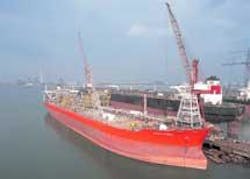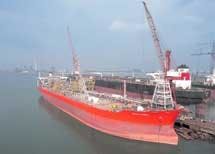West Africa
By Fed Akanni • Lagos
Gas bills indicate the way to a regional gas hub
Namibia and South Africa are independently working on gas legislation that should enable the Southern African neighbors to become sub-Saharan Africa's major gas hub.
The Namibian Gas Act, drafted by the Ministry of Mines, is aimed at promoting the establishment of a gas transportation and distribution network in Namibia for the purposes of domestic supply and export. The act would also establish a framework of licensing for the gas industry and a national gas regulator to monitor the performance of license conditions to ensure safety, efficiency, and environmental responsibility in the transportation and distribution of natural gas. The act hopes to facilitate investment in pipeline infrastructure, stimulate cross-border trade in gas between Namibia and its neighbors, and promote a competitive gas market in the long term.
Mozambique, Namibia, and South Africa have large gas reserves, but little oil. A fourth country, Angola, has huge reserves of oil, with gas that has always been flared.
A gas pipeline from Mozambique to South Africa is in the works to transport gas from the Pande and Temane gas fields in Mozambique, via Maputo, to Secunda in South Africa. When commissioned in 2004, it will be the first transporter gas pipeline supply within the African continent.
A commercial-sized gas field in Kudu offshore Namibia was proposed to be piped into Cape Town, South Africa, for electricity. But operator Shell has decided to go for the liquefied natural gas (LNG) option. Angola, too, is working on an LNG effort to commercialize its associated gas.
The South African Gas bill, now awaiting President Mbeki's signature, seeks goals similar to the draft version of the Namibian Gas Act. The bill purports to be aimed at "promoting the orderly development of the piped gas industry and provide for the establishment of an independent gas regulator."
It seeks an enabling environment for easy transmission, storage, and distribution as well as access to affordable gas. No doubt, gas will be a factor in the transborder trade in the Southern African Development Community. While North African countries seek gas export to Europe and the West African Gas Project lags far behind schedule due to the West African subregion being too poor and underdeveloped to utilize the proposed pipeline, South Africa itself is industrialized and has a market large enough to consume much of the gas produced in the region.
For Canadian Natural Resources, CÊote d'Ivoire is the place to be
Things are looking good for Canadian Natural Resources (CNR) in CÊote d'Ivoire. The independent put the Espoir oil field in Block CI-26 onstream at nearly the same time that it spudded an outpost to the Baobab discovery, located in another lease 30 km from Espoir. Appraisal Baobab-2 turned out to be more successful than the discovery, giving the company the guarantee of another cash cow off the West African country.
But first, the Espoir story. This was a field that was abandoned after six years of production by Phillips in 1988 as a result of depressed oil prices and accelerated depletion. The field delivered an average of 14,000 b/d and was abandoned after producing 31 MMbbl of 29° to 33° API oil and yielding 62 bcf of gas.
CNR threw a party in early March to mark the first oil from the field in 14 years. The start-up rate is 8,500 b/d from one well. Production is expected to ramp up to 30,000 b/d. The company estimates the remaining reserves to be 80 MMbbl of oil and 175 bcf of gas. Production has exceeded projections. At the beginning of the development plan, in 1999, the average annual peak oil rate was estimated at 20,000 b/d.
A second development phase will target the western lobe of the field. Oil is evacuated via the Espoir Ivoirien floating, production, storage, and offloading (FPSO) vessel, which is operated on behalf of CNR by Prosafe. Operator CNR has 58.67% of the field, Tullow Oil has 21.33%, and Petroci has 20%.
Baobab-2, located in CI-40, the drill stem test flowed 10,000 b/d on 60/64-in. choke from a 298 ft net pay zone, constrained by drilling equipment. The well reached total depth at 9,500 ft. Baobab-2 is in 5,000 ft water depth, a considerably greater depth than Espoir. The flow is consistent with that tested in the Baobab-1X well. The well was suspended for future use. The results from the test will help optimize field economics and will assist in planning a development scheme. Oil-in-place is now thought to exceed 700 MMbbl, and recoverable reserves are put at over 150 MMbbl.
Operators want out of deepwater Kwanza Basin
Several operators are looking for a way out of Angola's deepwater Kwanza basin. Blocks 19, 21, 22, 24, and 25 are on license in this basin, bounded by the Congo Fan in the north and the deepwater Namibe Basin in the south. ExxonMobil is offering its entire 20% interest in Block 21. So is British Petroleum. ExxonMobil also wants out of Texaco-operated Block 22, where it holds 25%. In Block 19, TotalFinaElf (TFE) is offering both its operatorship and its entire 30% interest, without having drilled a well. In Block 25, where Agip is 40% operator, ExxonMobil wants to divest its 35% interest. The apparent rush to get out seems to stem from the run of disappointing wells in this province in the last 12 months.
BHP's Iona -1 in Block 21, which was plugged and abandoned as a dry hole last September, was the third disappointing hole in nine months in the newly opened basin, located south of and contiguous with the prolific Congo Fan. The well reached total depth at 10,000 ft. In February 2001, Agip plugged and abandoned Leao-1 in Block 25, its only well in the basin, as a dry hole. In August 2001, ExxonMobil plugged and abandoned Eova-1, in Block 24, after judging the well to be sub-commercial. The only commercially successful well in the deepwater Kwanza Basin so far has been ExxonMobil's Semba-1, the company's first well on the same lease, which was abandoned on April 29, 2001, at TD 12,300 ft after testing a combined 3,039 b/d (low by Angolan deepwater standards) from two reservoirs. At press time, Agip has yet to spud Jaguar-1, a second location in Block 25. ChevronTexaco scheduled its first well in the basin for mid-2002.
Another factor that could be compelling operators to dump their portfolios in deepwater Kwanza is the spread of opportunities in deepwater West Africa and the cost to develop these opportunities. TFE, for one, just began producing the huge Girassol Field in Block 17 in the Congo Fan and has lined up Dalia, another elephant, for production. This has reduced the French major's enthusiasm for its Nigerian deepwater Akpo Field.
ExxonMobil is working up its Kizomba project in the prolific Block 15 and is involved in deepwater Nigeria, in the giant Erha Field as operator and Shell's Bonga Field as a partner.

